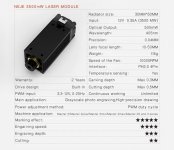I don't think you can with this diode and lens. You also have to understand what encap means. People have to pay money for this kind of consultation so to get anything for free is a blessing and a kind act. Maybe with a gas laser and some expensive optics you can get the focal point that small but man I dunno, I'm not an expert in that.
Wow... was it so hard so say that I had to pay to get "consultation" for such focal point.
Lets be honest achieving 0.01mm with +/- 0.01m tolerance focal point isn't rocket science.
But anyhow I wouldn't mind paying for valid schematics for optics to start with.
As long you're not beating me in the head with price.
Obviously in my right mind, I won't pay anything until I know you have a valid institution degree in the related field of optics/photonics engineering. If anyone can prove that they have such background, I'll pay for optical cad drawings/schematics and have a company produce the optics for me. But then again this is just a project of mine, I'm not a company that needs this by heart.
There's already an intelligent person who made a high resolution "Laser Direct Lithography" using "encap's" "garbage" parts give or take about $100 or so. The project is open source and it's called "LDGRAPHY".
Here is the link to the project:
github.com/hzeller/ldgraphy
It's not perfect for my needs since I need it for QFN and FPGA PCB trace circuits which needs about 0.07mm traces.
I'm here to ask "real knowledgeable" people how this open source technology can be perfected to get the laser's focal point at least 0.05mm accurately all day so that exposing/marking/etching the photoresist at 0.07mm will be no problem.
The creator for that LDI project states that his open source LDI creation is reliable up to "~0.15mm" marking.
Now for stupid monkeys like "encap", he obviously can't comprehend the level of achievement "LDGRAPHY" truly is (no seriously he cant).
One needs to understand that there was no freaking external lens involved, and for around $100, open source project like "LDGRAPHY" can give you "~0.15mm" accuracy, that's mind blowing if you asked me.
I'm actually building this "ldgraphy" LDI device, everything is well documented by the creator (I mean who wouldn't, specially people who likes to learn and design their own PCBs).
The creator gave some ideas how to improve his open source LDI, one of which is using an f-theta lens (which I will try to test with using a laser printer f-theta lens, delivery is on its way).
But hey, if someone is willing to perfect this down to 0.01mm for a price... then how much?




